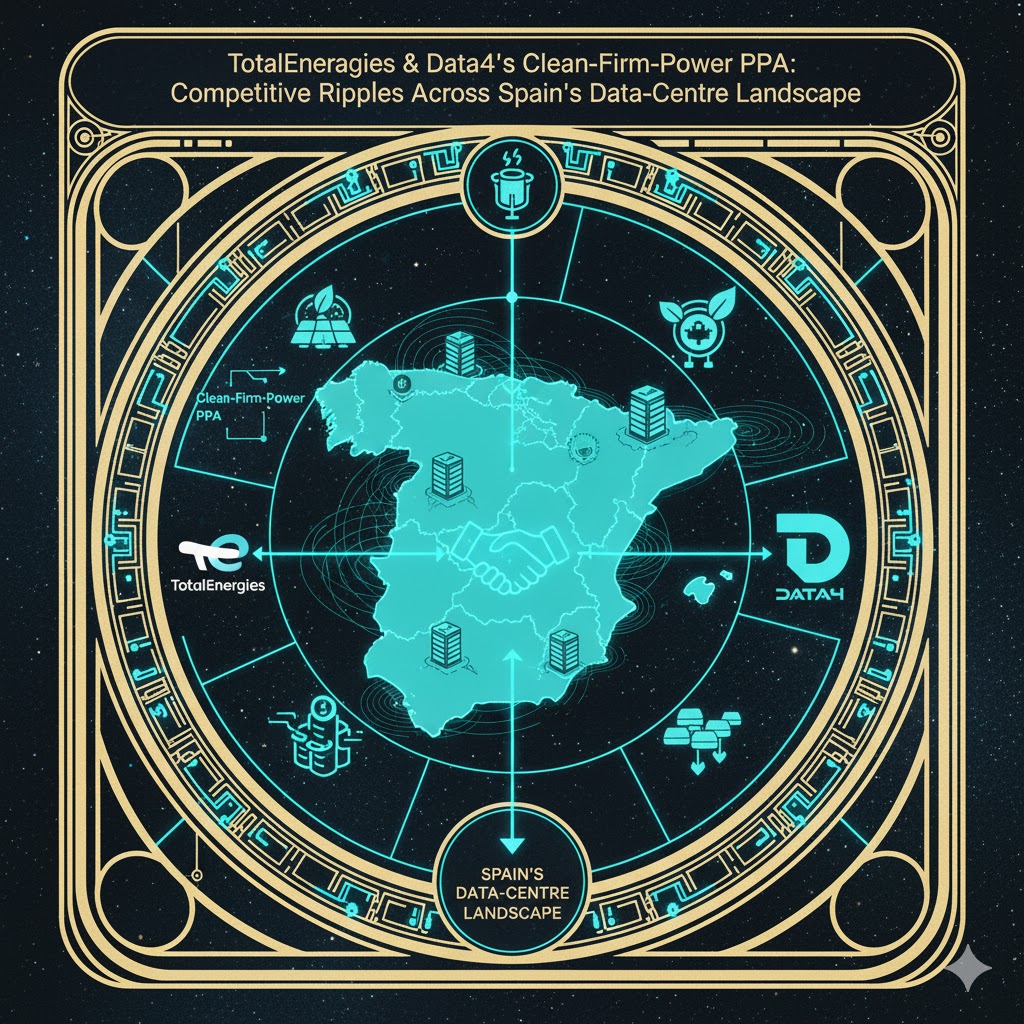Spain’s data‑centre boom and the energy bottleneck
Spain has rapidly become one of Europe’s fastest growing digital‑infrastructure hubs. The association Spain DC estimates that data‑centre power consumption reached about 200 MW in 2024 and could jump to around 730 MW by 2026—nearly tripling in two yearsstrategicenergy.eu. This explosive growth is part of a broader European trend: high‑performance computing (HPC) and artificial‑intelligence workloads are accelerating data‑centre demand while drawing more electricity. The European Commission notes that HPC underpins advances ranging from climate‑modeling and vehicle design to cybersecurity and biomedical researchdigital-strategy.ec.europa.eu. Goldman Sachs forecasts that global data‑centre power demand will grow 50 % by 2027 and 165 % by 2030, with AI workloads expanding from 14 % of data‑centre consumption in 2023 to roughly 27 % by 2027goldmansachs.com.
Spain’s grid, however, is struggling to keep up. By mid‑2025, Spain’s transmission operator Red Eléctrica reported that 85 % of transmission and distribution nodes had no available capacity for new demand, forcing developers to pair new data‑centre campuses with on‑site renewable generation and storagestrategicenergy.eu. Spain DC warns that the sector’s growth is constrained by access to electricity; large investments are ready, but real electrical capacity is scarcestrategicenergy.eu. In this context, long‑term power‑purchase agreements (PPAs) that provide guaranteed volumes of low‑carbon electricity have become essential for hyperscalers and data‑centre operators.
The TotalEnergies‑Data4 deal
On 4 November 2025, French energy major TotalEnergies and the European data‑centre operator Data4 announced a 10‑year PPA for Data4’s Spanish campuses. Starting in January 2026, TotalEnergies will supply around 610 GWh per year of renewable electricity generated from new Spanish wind and solar assets with a combined capacity of ≈30 MWtotalenergies.com. The contract, described as “Clean Firm Power,” provides electricity with a stable consumption profile tailored to the continuous load of data centrestotalenergies.com.
Key features of the deal:
| Aspect | Details |
|---|---|
| Term & volume | 10‑year PPA beginning January 2026; about 610 GWh per year of renewable electricity for Data4’s Spanish campusestotalenergies.com. |
| Source & capacity | Electricity supplied from newly built Spanish wind and solar farms representing roughly 30 MW of capacitytotalenergies.com. |
| Investment signal | Data4 plans to invest €2 billion in its Spanish campuses by 2030 and expects its energy requirements in Spain to more than triple over the periodtotalenergies.com. |
| Clean‑firm design | TotalEnergies bundles intermittent renewables with energy‑management and balancing services to provide a firm power product suited for data‑centre loadstotalenergies.com. |
| Strategic fit | Data4 operates 10 campuses across Europe with 1.5 GW of available power and over 220 carriersdata4group.com; the PPA secures long‑term low‑carbon supply for its Madrid‑based hyperscale expansion. |
How it reshapes competition
1 – Pressure on incumbent utilities
Data4’s choice of TotalEnergies rather than a Spanish utility is notable. Spain’s dominant players—Iberdrola, Endesa and Repsol—have been aggressively courting data‑centre customers with renewable PPAs.
- Iberdrola has established a dedicated data‑centre subsidiary and already supplies around 8 TWh per year of electricity to global data players such as Amazon, Meta, Apple and Microsoftspglobal.com. It expects demand from the sector to double globally by 2030 and plans to treble grid investment to meet Spain’s National Energy and Climate Planspglobal.com. The utility recently signed joint‑venture agreements with Echelon to build a 144 MW hyperscale campus south of Madrid, backed by on‑site solar PV and additional clean‑energy capacityiberdrola.com. In September 2025 Iberdrola secured a 12‑year nuclear‑energy contract with Data4 for its French campuses, providing 40 MW (≈230 GWh/yr) of low‑carbon supplydata4group.com.
- Repsol, Spain’s largest oil group, announced plans to invest €4 billion in a 400 MW data‑centre campus near its Escatrón combined‑cycle plant in Zaragozadatacenterdynamics.com. The project will leverage Repsol’s 3 GW renewable portfolio and aims to serve hyperscalers such as Amazon and Microsoftdatacenterdynamics.com. Reuters noted that the Zaragoza region is becoming a major cloud hub due to investments by Amazon and Microsoftreuters.com.
- Blackstone, the world’s largest alternative asset manager, has proposed a €7.5 billion hyperscale complex in Aragon and filed plans in August 2025 to invest an additional €4.3 billion in a second phase. The expansion would include eight data centres, a new substation, a photovoltaic plant and grid connections; crucially, Blackstone said it has already signed renewable electricity supply contracts and will use cooling systems that do not consume waterreuters.com.
- Digital Realty, a global colocation leader, has executed 15 PPAs in Europe delivering about 2,200 GWh annually and recently invested €500 million in two Spanish campuses in Madrid and Barcelona that will be fully powered by renewablesdigitalrealty.commadridinvestmentattraction.com.
TotalEnergies’ entry into this competitive field signals that oil and gas majors can leverage renewable portfolios and trading capabilities to compete with traditional utilities. The company has over 32 GW of installed renewables and aims for 35 GW by end‑2025totalenergies.com. By offering clean‑firm power, TotalEnergies differentiates itself from pure renewables suppliers and sets a precedent for bundled renewable‑plus‑balancing products that mitigate intermittency.
2 – Vertical integration of energy and data‑centre developers
The PPA showcases an emerging model where energy companies and data‑centre operators co‑develop large campuses. Iberdrola’s joint venture with Echelon and Repsol’s planned campus near its Escatrón plant exemplify integrated approaches, aligning generation and load at the site level. TotalEnergies’ deal falls short of full integration but signals a move toward hybrid renewable + storage + data‑centre ecosystems. Such integration can ease grid congestion by locating demand near generation, providing flexible load to balance variable renewablesstrategicenergy.eu.
3 – Incentivising regulatory reform
Spain’s regulators are under pressure to modernise the transmission‑planning process. Spain DC warns that electrical planning cycles of four‑to‑five years are too slow and that speculative grid‑connection requests are blocking real investmentsstrategicenergy.eu. By committing to long‑term PPAs linked to new generation, companies like TotalEnergies and Data4 provide credible demand signals that could accelerate network upgrades and foster collaboration with Red Eléctrica to differentiate genuine from speculative projectsstrategicenergy.eu.
Impact on customers and verticals
Data4’s campuses host customers across multiple industry verticals. The PPA’s clean‑firm power offering has implications for each:
Hyperscale cloud and AI providers
Hyperscalers such as Amazon Web Services (AWS), Microsoft Azure and Google Cloud are the anchor tenants of most Spanish data‑centre projects. They have announced multi‑billion‑euro investments around Zaragoza and Madrid; AWS and Microsoft have each signed renewable PPAs in Spain and rely on low‑carbon power to meet corporate net‑zero commitmentsreuters.comreuters.com. AI workloads are extremely energy intensive—Goldman Sachs projects that AI‑related consumption will represent 27 % of data‑centre power by 2027goldmansachs.com—so access to stable renewable energy is now a key criterion for site selection. Data4’s ability to deliver 24/7 clean power through TotalEnergies positions its Madrid campus as an attractive location for training large language models and offering AI‑accelerated cloud services.
High‑performance computing (HPC) and scientific research
Europe’s digital‑sovereignty strategy emphasises HPC for climate modelling, drug discovery, advanced materials and cybersecuritydigital-strategy.ec.europa.eu. Exascale machines like JUPITER, inaugurated in September 2025, will require tens of megawatts of continuous power. The Data4–TotalEnergies PPA provides a template for supplying clean, firm electricity to HPC facilities, aligning with European goals of reducing the carbon footprint of supercomputing. Data4’s participation in the DCFLEX initiative with RTE and Schneider Electric further illustrates its ambition to integrate data centres into the electricity grid and test flexibility servicesdata4group.com.
Telecommunications and edge computing
Spain’s telecom operators and content delivery networks depend on regional data‑centre hubs to support 5G, edge computing and video streaming. Data4 operates highly connected campuses with over 220 carriersdata4group.com. The clean‑firm power supply ensures low latency and reliability for edge workloads such as autonomous vehicles, Internet‑of‑Things platforms and real‑time gaming. With grid congestion a concern, the PPA’s combination of local generation and firming could prevent curtailment and maintain service quality.
Financial services, healthcare and industry
Banks, insurers and fintech companies process sensitive transactions and require resilient colocation facilities. Healthcare and life‑sciences firms run genomics and imaging workloads, while manufacturers deploy digital twins and Industry 4.0 applications. These verticals increasingly face regulatory pressure to decarbonise their supply chains. By contracting with Data4, enterprises can claim that their digital infrastructure is powered by certified renewable energy, advancing their Environmental, Social & Governance (ESG) goals. The long‑term nature of the PPA also shields tenants from volatile electricity prices, providing cost certainty amid Spain’s volatile wholesale market (Spanish solar PPA prices averaged €33.99/MWh in July 2024spglobal.com).
Government and defence
The Spanish public sector and European institutions are expanding secure cloud environments for sensitive data, including defence and intelligence applications. Data4’s emphasis on data sovereignty and its partnership with EDF to secure 40 MW of nuclear energy for its French facilitiesdata4group.com demonstrate a commitment to energy security and independence. TotalEnergies’ PPA extends this model to Spain, making Data4 a trusted partner for sovereign workloads.
Broader implications
The TotalEnergies–Data4 agreement is more than a procurement contract; it illustrates how the convergence of energy and digital infrastructure is redefining competition and customer expectations. Energy companies that can deliver firm, low‑carbon power and act as partners in campus development will gain a foothold in the data‑centre market. Data‑centre operators that secure diverse, long‑term energy sources—solar, wind, nuclear and alternative fuels—will attract hyperscalers and HPC clients seeking reliability and sustainability. For Spain, the deal underscores the need for proactive grid regulation and accelerated network investments to capture the next wave of AI‑driven growth.strategicenergy.eu
As AI and digitalisation drive unprecedented electricity demand, the winners will be those who can pair clean electrons with smart electrons—combining renewable generation, flexibility services and intelligent load management to deliver the digital future without compromising the energy transition.









